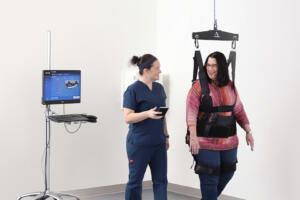Monroe High School senior Sami Hughes, 16, was diagnosed with scoliosis during a routine screening in elementary school. She wore a series of back braces for three years to correct the curvature in her spine, but the treatment wasn’t a permanent fix. When back pain threatened to sideline her participation in her school’s color guard, Sami and her mother, Maria, searched for a nonsurgical solution and found CentraState’s Schroth 3D Treatment for scoliosis.
“Having scoliosis made performing in color guard more difficult because I was in pain and felt I wasn’t strong enough to complete the movements with my flag,” says Sami, who also plays guitar, ukulele, and keyboard. “My back hurt while just sitting in a chair.”
Because Sami wanted to avoid surgery, a pediatric orthopedist recommended that she try Schroth physical therapy. In April, she met with Jacqueline Maclearie PT, DPT, Cert MDT, Schroth-trained and McKenzie Method-certified physical therapist at the OceanFirst Rehabilitation Center at CentraState. Jacqueline reviewed X-rays of Sami’s spine and performed an assessment of her posture, trunk balance, spinal alignment, and movement mechanics.
“Sami’s curve pattern was severe and worsening,” Jacqueline explains. “It was causing pain in her back as well as her shoulder.”
A Nonsurgical Solution for Scoliosis-Related Pain
Schroth therapy includes treating patients at all planes of the body, making it a 3D approach to treatment. It involves cognitive, sensory-motor, and kinesthetic training, along with exercises designed to promote symmetry and improve alignment. Meeting twice a week, Jacqueline showed Sami a series of stretching exercises designed to realign the body. Mirrors helped Sami become more aware of her body to enable her to correct any issues.
“Your body is like a peppermill; you can rotate the top or the bottom to realign and elongate the body,” Jacqueline explains.
After about a dozen therapy sessions over six weeks, follow-up X-rays revealed that the curve in Sami’s spine had stabilized and was no longer progressing. Now, Sami knows how to adjust her body without prompting. Her spine and trunk measurements are taken routinely to reassess her condition—and her improvement—without unneeded radiation through X-raying.
“When children are diagnosed with scoliosis, the condition may worsen as they grow, so early screening and treatment can be crucial to stop the progression,” Jacqueline says.
Now, Sami is no longer in pain. She’s standing taller, which has improved her self-esteem. And perhaps more importantly, she’s looking forward to her last year of color guard.
“Therapy has made me a stronger person,” Sami says. “Color guard is a lot easier for me this year, and I’m no longer in pain. I wish I had started therapy years ago.”
For more information about Schroth therapy at CentraState, visit centrastate.com/pediatrics or call 866-CENTRA7 (866-236-8727).





